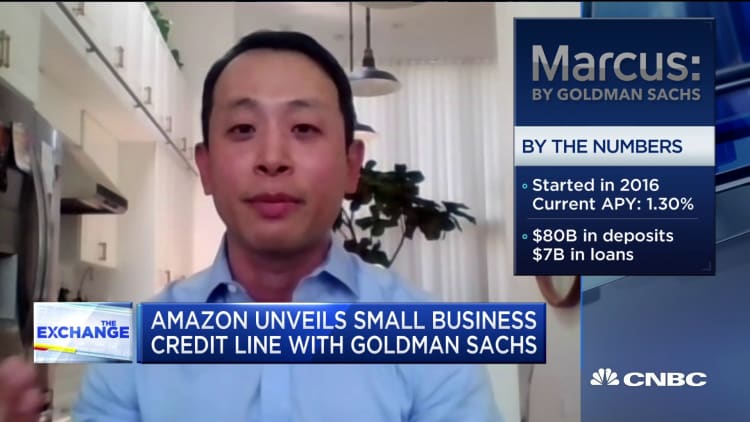
Amazon is introducing a new digital credit line for U.S.-based merchants with partner bank Goldman Sachs, CNBC has learned exclusively.
Small business owners who sell items on the e-commerce giant's platform will soon be receiving targeted invitations from Goldman's Marcus brand for credit lines of up to $1 million, according to people with knowledge of the project.
Potential borrowers will see the offer on Seller Central, the online hub for Amazon merchants and can apply in a simple two-step process, said the people, who spoke on condition of anonymity because they were not authorized to discuss the partnership publicly. The credit lines will come with a fixed annual interest rate of 6.99% to 20.99% and can be drawn and repaid, like a regular credit card.
The move — the latest high-profile collaboration between the worlds of technology and banking — is the first time Amazon will let a financial institution make underwriting decisions for the hundreds of thousands of sellers on its platform. More than half the goods sold on Amazon are from independent businesses. For the past decade, Amazon has kept a tight rein on its small business lending program, using algorithms and closely guarded sales data to determine who could use a loan.
Now, in a sign of the close relationship between the two companies — Amazon used Goldman bankers for its $13.7 billion takeover of Whole Foods — the tech giant will share merchant data with Goldman, the people said. If sellers consent to it, Goldman will use data on businesses' revenue and tenure on the e-commerce platform to help determine who should be approved, the people said.
"We're super excited about embarking on this journey with Amazon, and thrilled that they chose to partner with us," said Omer Ismail, head of Goldman's U.S. consumer business.
The move is a coup for Goldman, which is working to expand its ecosystem of partners. Besides offering personal loans and deposits under its Marcus brand, CEO David Solomon said in January that the firm hoped to become a "banking-as-a-service" provider for big corporations. Last year, Goldman helped Apple launch its first iPhone-integrated credit card and followed that with a partnership with JetBlue. The bank also has deals with Intuit and AARP.
By gaining data on thousands of Amazon merchants, Goldman can improve its lending models and accelerate its push into Main Street finance. For most of its 150-plus year history, the bank has focused on Wall Street clients and the ultra-wealthy. The bank started its Marcus business in 2016 to diversify from the capital markets-heavy businesses that generate most of its revenue.
Amazon only shares data if sellers agree to it, and Goldman will only use that data for credit lines, not to make other product offers, the people said. Amazon won't have access to data that Goldman collects for its qualification process, they added.
It could have gone differently: Amazon had considered creating an online marketplace where Goldman would be just one of many lenders competing to offer small businesses credit, according to the people. That strategy was dropped in favor of working solely with Goldman, the people said.
In February, the Financial Times reported that Goldman and Amazon were close to striking a deal to offer small business loans. But the project had actually been in development since mid-2018, shortly before Solomon formally took over at the bank, said the people.
Internally, Goldman executives referred to it as Project Augusta, an alliterative play on the name of its partner and a reference to the premier golf tournament. At Amazon, the project was referred to more prosaically as 3PL, or third-party launch, for the first time an outside company would lend to its sellers.
The Goldman team started by interviewing Amazon sellers to find what they needed in a finance product. Merchants typically get paid every two weeks, which can cause a cash crunch during high-sales periods like the holidays. So a credit line offers much-needed flexibility to buy more inventory or invest in marketing or product development when needed.
The application process is fully digital and can be done in minutes, and most customers will get approval results in real time. Unlike with other Marcus products, however, there are potential fees. The credit line runs on a two-week cycle, and if users don't make minimum payments on time, they'll owe late fees. They'll also pay a maintenance fee if they don't use at least 30% of their credit line, the people said.
Goldman will service these credit lines, adding to the portfolio of regular Americans that the bank now interacts with.
"Our team exists to fuel seller growth, period," Ragui Selwanes, head of Amazon Lending, said in a statement. "Marcus is the right partner for us because they share this commitment."
The Goldman credit line will compete with the term loans that Amazon has been offering for years. In 2019, Amazon said, it loaned over $1 billion to 14,000 U.S.-based sellers. For these loans, Amazon uses a corporate credit facility from Bank of America, and that relationship remains intact, one of the people said.
While Goldman is a late arrival to retail finance, it shouldn't be dismissed. After four years, the bank has $80 billion in deposits and $7 billion in loans, and there are signs it is gaining momentum. The upheavals caused by the rise of fintech and more recently, the coronavirus pandemic, could provide an opening for it to exploit its advantages.
"On the one hand, we are a bank with a balance sheet, with the ability to lend, and manage risk effectively," Ismail said. "On the other hand, we're doing this with all the benefits of being a start-up, i.e. no legacy technology, no legacy business models."


